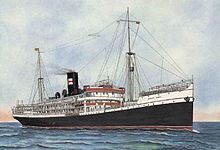Infanta Isabel (ship, 1912)
|
||||||||||||||||||||||
|
||||||||||||||||||||||
|
||||||||||||||||||||||
|
||||||||||||||||||||||
The Infanta Isabel was a 1912 passenger ship of the Spanish shipping company Pinillos Izquierdo y Compañía, which operated between Spain and South America . The ship was later sold to Japanese owners and sunk on September 21, 1944 in service as a troop transport under the Japanese flag by the American submarine Redfish north of the Philippines .
The ship
The Infanta Isabel was the sixth ship of the Spanish steamship company Pinillos Izquierdo y Compañía, founded in 1884 and based in Cádiz . The shipping company was generally called Pinillos Line for short and had specialized in passenger traffic from Spain to Central and South America with stopovers in the Canary Islands. She was a passenger ship of the type and was built by the Scottish shipyard Russell & Company in Port Glasgow according to the classification regulations of Lloyd's Register of Shipping . With a volume of 8182 GRT, she was the largest ship of the shipping company until then.
In 1914, the Infanta Isabel's sister ship , the Príncipe de Asturias (8,371 GRT), was commissioned and sank off the Brazilian coast two years later. Both ships were used for the express service from Barcelona and Cádiz via Las Palmas to Rio de Janeiro , Montevideo and Buenos Aires , for which they needed 14 days. On September 10, 1912, the Infanta Isabel left on her maiden voyage . You and the Príncipe de Asturias were in direct rivalry with the luxury steamers Infanta Isabel de Borbón and Reina Victoria Eugenia (both over 10,000 GRT) of the shipping company Compañía Trasatlantica Española ( Spanish Line ), which was considered the greatest competitor of the Pinillos Line.
Furnishing
The 140.06 meter long and 17.68 meter wide steamship Infanta Isabel was launched on June 29, 1912. It had a chimney, two masts and two bronze propellers. The two quadruple expansion steam engines came from the David Rowan Company of Glasgow and developed 8,000 hp. The hull was divided into several watertight compartments and had a double floor . In order to contain vibrations, the ship was equipped with the Yarrow, Schlick & Tweedy balance system.
The passenger accommodation of the Infanta Isabel was designed for 150 guests of the first class, 120 of the second, 120 of the third ("second economic") and about 1500 in the tween deck. The first class rooms were completely in the Louis XIV style. These included a dining room paneled with oak and walnut with rectangular windows instead of round portholes , which was crowned by an elliptical glass dome, an entrance hall, a music salon, a writing salon, a library , a hairdressing salon, a bar and a smoking salon with armchairs covered with Moroccan leather were.
On the promenade deck were the first-class luxury suites, which consisted of a living room, bedroom and a private bathroom and could accommodate two or four people. The ship was equipped with electric lights , wireless telegraphy and an electrically operated cooling and ventilation system. The safety equipment included 14 lifeboats.
Under the Japanese flag
The loss of three ships within three years (1916 to 1919) meant the end of the Pinillos Line. In 1925 the remaining ships in the fleet were sold to the Compañía Oceanica in Barcelona. The Infanta Isabel was sold to Ōsaka Shōsen Kaisha ( 大阪 商船 会 社 ) the following year and renamed Mizuho Maru ( 瑞 穂 丸 ). From 1937 it was used in the military, first in the Second Sino-Japanese War as a troop transport and then in the Second World War as a hospital ship . On September 21, 1944 she was north of the Philippine main island Luzon in position 18 ° 37 ' N , 120 ° 43' O from the redfish (Commander Louis D . McGregor), a US Balao- class submarine , torpedoed and sunk.

